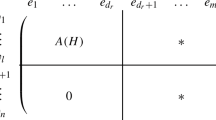Abstract
The article examines binary codes obtained from the row span of the adjacency matrices of some strongly regular graphs that occur as induced subgraphs of the McLaughlin graph, namely those with parameters (105, 32, 4, 12), (120, 42, 8, 18) and (253, 112, 36, 60). In addition we determine some primitive designs that are held by codewords of particular weights in the codes, and using the properties of the graphs and their geometry we provide a geometrical description of the nature of several classes of codewords. The codes with parameters [120, 100, 6]2 and [120, 101, 6]2 are near optimal as they are a distance 2 and 1 respectively more than the theoretical upper bound on the minimum distance for a code of the given length and dimension. Those with parameters [105, 87, 5]2 and [253, 231, 5]2 are a distance 1 less that the known recorded distance.
Similar content being viewed by others
References
Assmus E.F., Jr., Key J.D.: Designs and their Codes. Cambridge University Press, Cambridge, 1992. Cambridge Tracts in Mathematics, Vol. 103 (Second printing with corrections, 1993).
Bosma W., Cannon J., Playoust C.: The Magma algebra system I: The user language. J. Symb. Comput. 24(3/4), 235–265 (1997)
Brouwer A.E., van Eijl C.J.: On the p-rank of the adjacency matrices of strongly regular graphs. J. Algebraic Combin 1, 329–346 (1992)
Brouwer A.E., Haemers W.H.: The Gewirtz graph: an exercise in the theory of graph spectra. Eur. J. Combin. 14(5), 397–407 (1993)
Brualdi R.A., Huffman W.C., Pless V.S.: An introduction to algebraic codes. In: Pless, V.S., Huffman, W.C. (eds) Handbook of Coding Theory, Vol 1, Part 1, Chapt. 1., pp. 3–139. North Holland, Amsterdam (1998)
Buekenhout F., Leemans D.: A rank six geometry related to the McLaughlin sporadic simple group. Des. Codes Cryptogr 44, 151–155 (2007)
Calderbank A.R., Wales D.B.: A global code invariant under the Higman-Sims group. J. Algebra 75, 233–260 (1982)
Conway J.H., Curtis R.T., Norton S.P., Parker R.A., Wilson R.A.: An atlas of finite groups. Oxford University Press, Oxford (1985)
Coolsaet K.: The uniqueness of the strongly regular graph srg (105,32,4,12). Bull. Belg. Math. Soc Simon Stevin 12(5), 707–718 (2005)
Coolsaet K., Degraer J.: Classification of some strongly regular subgraphs of the McLaughlin graph. Discret. Math 308(2-3), 395–400 (2008)
Crnković D., Mikulić V., Rodrigues B.G.: Some strongly regular graphs and self-orthogonal codes from the unitary group U 4(3). Glas. Mat. Ser. III. 45(65), no. 2, 307–323 (2010).
Dankelmann P., Key J.D. Rodrigues B.G.: Codes from incidence matrices of graphs. Des. Codes Cryptogr. (2011). doi:10.1007/s10623-011-9594-x.
Diawara O.: Sur le groupe simple de J. McLaughlin. PhD thesis, Université Libre de Bruxelles, Belgium (1984).
Grassl M.: Bounds on the minimum distance of linear codes and quantum codes. Online available at http://www.codetables.de (2007). Accessed on 09–11–2011
Goethals J.-M., Seidel J.J.: The regular two-graph on 276 vertices. Discret. Math. 12, 143–158 (1975)
Haemers W.H., Peeters R., van Rijckevorsel J.M.: Binary codes of strongly regular graphs. Des. Codes Cryptogr 17, 187–209 (1999)
Jansen C., Lux K., Parker R., Wilson R.: An atlas of Brauer characters. Oxford Scientific Publications, Clarendon Press, Oxford. LMS Monographs New Series 11, 373–394 (1995)
Key J.D., Moori J., Rodrigues B.G.: Permutation decoding for binary codes from triangular graphs. Eur. J. Combin 25, 113–123 (2004)
Key J.D., Seneviratne P.: Permutation decoding of binary codes from lattice graphs. Discret. Math. 308, 2862–2867 (2008)
McLaughlin J.: A simple group of order 898,128,000, Theory of finite groups (symposium, Harvard Univ., Cambridge, Mass., 1968), pp. 109–111 Benjamin, New York (1969).
Moori J., Rodrigues B.G.: Some designs and codes invariant under the simple group Co2. J. Algebra 316, 649–661 (2007)
Peeters R.: Uniqueness of strongly regular graphs having minimal p-rank. Linear Algebra Appl 226/228, 9–31 (1995)
Rodrigues B.G.: Some optimal codes from graphs invariant under the alternating group A 8. Adv. Math. Commun 5(2), 339–350 (2011)
Soicher L.H.: Three new distance-regular graphs. Eur. J. Combin 14(5), 501–505 (1993)
Tonchev V.D.: Binary codes derived from the Hoffman-Singleton and Higman-Sims graphs. IEEE Trans. Inf. Theory 43, 1021–1025 (1997)
Author information
Authors and Affiliations
Corresponding author
Additional information
Communicated by D. Ghinelli.
Rights and permissions
About this article
Cite this article
Leemans, D., Rodrigues, B.G. Binary codes of some strongly regular subgraphs of the McLaughlin graph. Des. Codes Cryptogr. 67, 93–109 (2013). https://doi.org/10.1007/s10623-011-9589-7
Received:
Revised:
Accepted:
Published:
Issue Date:
DOI: https://doi.org/10.1007/s10623-011-9589-7



